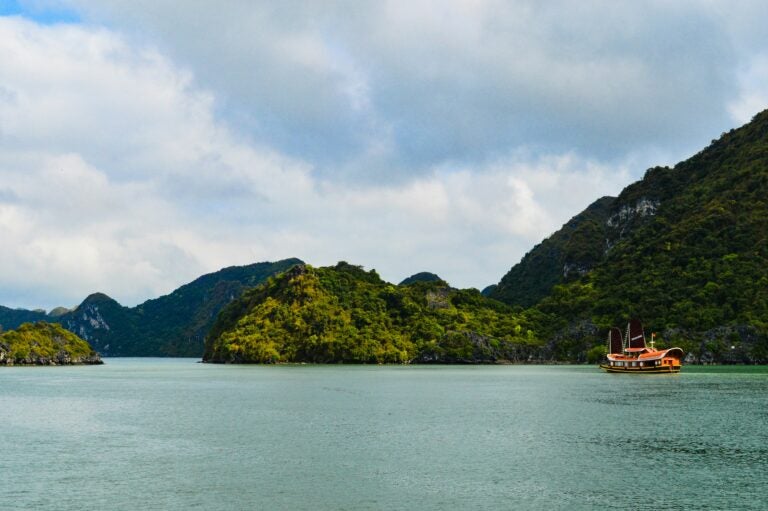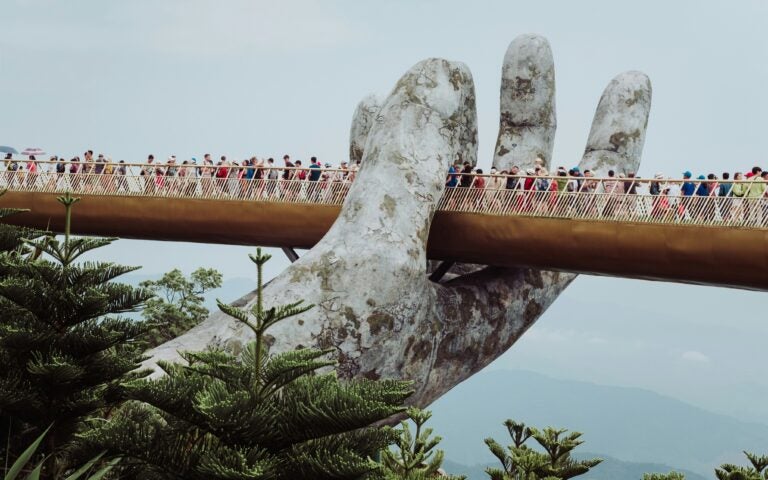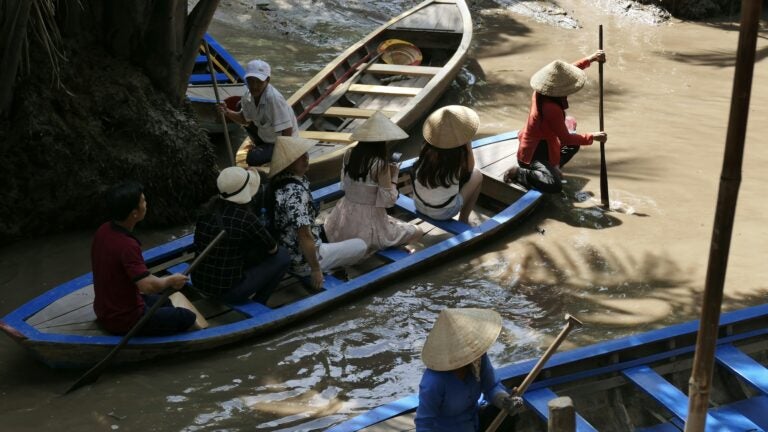The best time to visit Vietnam: Your guide to the perfect time of year
From hiking in Sapa to relaxing on a beach in Phu Quoc Island, find out how to plan your itinerary around Vietnam’s seasonal patterns and make the most of your trip.
With its stunning landscapes and rich cultural heritage, Vietnam is a must-visit destination for anyone considering a Southeast Asian vacation. It’s also super-affordable.
For the best experience, you need to plan your itinerary around Vietnam’s range of microclimates and unmissable festivities — as weather patterns in Vietnam vary by region, from north to south. Depending on what you want to do and where you want to go, here are the best times to visit Vietnam.
When is the best time to visit Vietnam?
The best time to visit Vietnam is March to April. During this period, temperatures are moderate and rainfall is low.
These months are pleasant throughout the country, with moderate temperatures and low rainfall. Perfect for hiking in Sapa, cruising in Ha Long Bay, sightseeing in Hoi An, and vacationing at the many beautiful Vietnamese beaches in Phu Quoc.
Best time to visit Vietnam by region
Vietnam’s climate is diverse, influenced by both its geography and topography. Northern Vietnam experiences four distinct seasons.
But in Central and Southern Vietnam, it’s more tropical — hot and humid, with distinct wet and dry seasons.
Here’s a breakdown of the best times to visit each region, so you can stick to your itinerary without any potential weather disruptions.
North Vietnam: Month to month
Best months: March to May, September to November
North Vietnam experiences all four seasons: Winter (December-February), Spring (March-May), Summer (June-August), and Fall (September-November).
Winters can be chilly, with nighttime temperatures dipping below freezing in January. Summers are hot and humid, there’s heavy rainfall and even occasional flooding in coastal regions.
So plan your visit to North Vietnam for Spring and Fall. The weather is generally mild and dry, making it perfect for outdoor activities and sightseeing.
Things to do
- Hiking in Sapa: Plan your trek for Spring to see the wildflowers in bloom, or in Autumn for stunning views of the golden rice terraces just before harvest.
- Cruising Ha Long Bay: Go in the Fall — the mild weather, low humidity, and contrast between turquoise waters and burnt gold foliage make for some pretty dramatic photos.
- Exploring Hanoi: Book your trip for September to November. The weather remains pleasant, and you won’t have to deal with huge crowds.

Central Vietnam: Month to month
Best months: February to April
Central Vietnam experiences a tropical monsoon climate characterized by distinct dry and rainy seasons.
The dry season is from January to August, and it’s warm and sunny with little to no rain — perfect for beach vacations.
Make sure to add sunscreen, hats, and rehydration salts to your Vietnam packing list because UV exposure is quite high during these months, particularly in May and June.
The rainy season (September-December) is very humid with heavy rainfall. Coastal areas like Hue and Hoi An also experience tropical storms, mainly in September and October when the rains are at their heaviest.
Plan your Central Vietnam trip for the dry season, February to April — the weather is mild, and the sun is less intense.
Things to do
- Caving in Phong Nha-Ke Bang: The best time for cave tours is February to April as the dry weather makes exploration easier.
- Vacationing at Da Nang: Plan your trip between March and August for sunny beach days or anytime between February and September for great views from the Golden Bridge (Ba Na Hills).
- Exploring Hoi An: Anytime during the dry season works, but try to be there on a Full Moon Night to experience the monthly Hoi An Lantern Festival — where the entire town is illuminated with colorful lanterns.

South Vietnam: Month to month
Best months: November to February
Just like central Vietnam, the southern region also has a tropical monsoon climate characterized by two distinct seasons: the dry season and the rainy season.
The dry season is from November to April, with February being the driest month. There’s a lot of sun, humidity is low, and you can expect around 2-5 days of rain, at most.
The rainy season is from May to October, with August and September being the peak typhoon months.
If you don’t mind a little rain, August to November is a great time to check out the floating markets. The Mekong River floods the surrounding lowlands — transforming the region into a network of waterways.
Things to do
- Boating in Mekong Delta: The best time to visit is from November to April. The rivers are calm, making for a pleasant experience.
- Visiting Phy Quoc Island: If your goal is a beach vacation, then any time between November to April would work. And if you want to see Suoi Tranh Waterfall at its best, go in November or December — the water levels are still high from the recent rainy season.
- Sightseeing in Ho Chi Minh City: Anytime during the dry season works, between late January and mid-February is best as you can also participate in the city’s Lunar New Year Celebrations (Tet Festival).

Best time to visit Vietnam for festivals
The weather isn’t the only thing that should dictate your Vietnam travel dates. Visiting Vietnam during one of its many festivals is a great way to experience the culture and participate in age-old customs — like wearing red during the Tet Festival to invite good luck.
Tet Festival
Date: Between late January and mid-February
Tet Nguyen Dan, commonly referred to as Tet, is the Vietnamese Lunar New Year. It’s usually celebrated between late January and mid-February, depending on the lunar calendar.
Like most ancient festivals, Tet also marks the beginning of spring — a new cycle of wet rice cultivation — in the North of Vietnam.
Tet celebrations last around a week, starting three days before the Lunar New Year and lasting a while after.
And with people from all over the country returning home for the celebrations, things can get chaotic. If possible, book your hotels and transportation in advance.
Here are some other things to look out for:
- Most cities organize firework displays on Tet Eve, so make sure to head outdoors at midnight to catch the show.
- Sample traditional Tet foods such as banh chung (square sticky rice cake) and banh tet (cylindrical sticky rice cake).
- Visit one of the temples or pagodas to experience local customs and rituals firsthand. Depending on where you are, you could explore Jade Emperor Pagoda (Ho Chi Minh), Quan Cong Temple (Hoi An), and Ngoc Son Temple (Hanoi).
If you’re in Hanoi (North Vietnam) around this time, visit the Quoc Huong Shop on Hang Bong Street. They’ve been selling banh chung (square rice cake) for over 200 years.
If you plan to celebrate Tet in South Vietnam, head to Ho Chi Minh City. The Nguyen Hue Flower Street’s elaborate floral displays are spectacular.
And of course, don’t forget to say Chuc Mung Nam Moi (Happy New Year!) when you meet a local in the first few days of the new year.
Mid-Autumn Festival
The Mid-Autumn Festival (Tet Trung Thu) is Vietnam’s Harvest Festival. It’s celebrated on the 15th day of the eighth lunar month — late September or early October.
This festival marks the end of the harvest season. It’s also the time to honor the Earth Deity and ancestors by preparing altars adorned with offerings of cakes, fruits, incense, and flowers.
If you’re attending the festival, here are three things to look out for:
- Lantern parades: The parades typically happen on the night of the full moon, and the best places to check them out are Hang Ma in Hanoi and Luong Nhu Hoc Lantern Street in Ho Chi Minh City.
- Lion dances: Performers dressed as lions dance to the beat of drums, cymbals, and gongs to ward off evil spirits. You can catch a performance at public squares, community centers, and even some resorts.
- Mooncakes: Also called banh trung thu, these are round pastries that come in various flavors and fillings. They are traditionally offered at ancestral altars and shared with family and friends to invite good luck. You can find them at most local bakeries.
Most cities also host mooncake and lantern-making workshops, which can be fun activities to try. If you’re in Hoi An, don’t forget to take a boat ride on the Hoai River and release a lantern with a wish written on it.
Hung Kings’ Festival
The Hung Kings are said to have established the first Vietnamese state, Van Lang, around 2,879 BC.
The Hung Kings Festival, also known as the Death Anniversary of the Hung Kings, honors these legendary rulers. It is held annually from the 8th to the 11th day of the third lunar month (around April).
For an authentic experience, celebrate the Hung Kings’ Festival at the Hung Temple Complex on Nghia Linh Mountain in Phu Tho Province (56 miles from Hanoi).
The festival features solemn ceremonies led by Buddhist monks and a grand procession that starts at the foot of Nghia Linh Mountain where locals carry offerings to the temple.
When visiting, make sure to:
- Try traditional foods like banh chung (square sticky rice cake) and banh giay (round sticky rice cake).
- Watch a Xoan Singing Performance at the Hung Temple Complex — a form of Vietnamese folk music that combines intricate melodies with dramatic storytelling.
What is the cheapest time to visit Vietnam?
The cheapest time to visit Vietnam is during the low season, which typically lasts from May to September.
As this coincides with the rainy season in North and Central Vietnam, be prepared for unpredictable weather. If you don’t mind the rain, you can enjoy fewer crowds and discounted prices offered by hotels and travel agencies to attract visitors.
This is when Vietnam’s nature is at its best. It’s the only time you’ll see North and Central Vietnam in full bloom (the South has flowers year-round). The rice terraces in Phong Nha-Ke Bang National Park are also beautiful during this time.
And while you might not be able to trek in Sapa, the higher water levels make river rafting and kayaking so much better. For cruising through Halong Bay, May to mid-June and the end of September are best — that way you escape Typhoon Season.
When to avoid visiting Vietnam
Generally speaking, it’s best to avoid the rainy season — particularly July to August — when visiting Vietnam.
There’s heavy rainfall and frequent thunderstorms, and the waters are mostly choppy. The roads get damaged (disrupting transportation), and you probably won’t be able to go to the beach or hike in Vietnam, either.
Here are some specific guidelines:
- Avoid North Vietnam from June to August: Trekking in Sapa gets dangerous due to mudslides and flooding. Potential storms in Ha Long Bay make boat tours less enjoyable.
- Avoid Central Vietnam from September to October: This is when Hoi An experiences its heaviest rains, and swimming on beaches like Da Nang also gets risky.
- Avoid South Vietnam from June to August: This time of year comes with a higher risk of flooding in the Mekong Delta and Ho Chi Minh City.
Get reliable internet in Vietnam with Holafly
Despite its stark seasonal contrasts, Vietnam is a fantastic holiday destination for most of the year. And while you’re packing for your Vietnam adventure, don’t forget to secure a mobile internet connection for your trip.
You’ll need it for everything, from getting restaurant recommendations to booking a tour guide.
Grab your Holafly eSIM for Vietnam to get unlimited data and roaming-free international VOIP calls at affordable rates.
For example, the Holafly eSIM for Vietnam gives you unlimited data for just $3.90 per day. The longer your plan, the lower the daily rate. For a 14-day trip, it’s just $3.42 per day.





 Language
Language 


















 No results found
No results found













